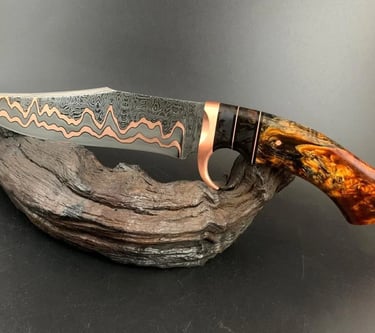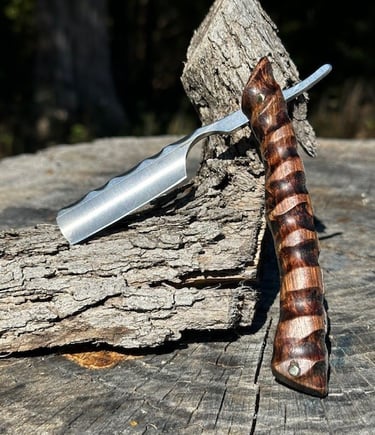Blade Care Essentials
Learn how to maintain Damascus and stainless steel blades for longevity and optimal performance.
Blade Care Experts
What Is Damascus Steel?
Damascus steel, a marvel of ancient craft, traces its origins to the lands of India, where it first bore the name of wootz steel. From 300 BC to the year 1700 AD, this mystical metal found its place among the finest swords ever forged. Its flowing, water-like patterns, with their bands and ripples, captivated the hearts of warriors and collectors alike.
Esteemed for its strength and ability to withstand the perils of battle, yet yielding to the whetstone to take a razor’s edge, Damascus steel was revered far and wide. Crafted from many metals, it is forged in fire, folded and hammered into a billet. Layer upon layer, the steel is wrought, until the desired form takes shape.
Though the ancient ways of its creation have faded into time, a few dedicated souls—artisans of the highest skill—still keep the fires of this noble craft alive. Damascus steel has earned a place in legend, likened to the mythical Valyrian steel, celebrated in tales of strength and valor.
How Is Damascus Steel Made?
In the halls of Warhammer Blades, our master smiths labor over months, sometimes years, to create each blade, a work of art and power. The forging begins with the careful selection of steel—each piece chosen with the utmost care. These metals are heated until they glow with the heat of a forge, then hammered and welded together.
In time, the billet grows under the hammer’s blow, folded over itself again and again, with each strike adding to its character. The smiths, with their anvils and hammers, coax forth intricate patterns, using high-carbon steel and other alloys to create the famed contrasts of Damascus.
How Strong Is Damascus Steel?
Damascus steel, renowned for its beauty, does not forsake strength. Its mettle, though not the hardest of all, is more than capable of enduring the tests of time and task. When forged with care and the wisdom of skilled hands, the blade will bear no crack, nor flaw, nor weakness.
Some say that carbon Damascus, though softer in its raw state, becomes as strong as tempered steel when hardened. Stainless Damascus, meanwhile, retains its beauty and strength, ever ready for whatever challenge awaits.
How To Make Different Patterns of Damascus Steel
The patterns of Damascus steel, as varied as the stars in the night sky, are shaped by the skill and vision of the blacksmith. Some billets may be kissed by copper, their patterns shimmering like a sunburst at dawn. Others weave together layers of stainless steel and nickel silver, creating waves that ripple across the blade like a flowing river.
The master smith must sacrifice much, for in the making of these wondrous patterns, much steel is cast aside. Yet from the scrap, a work of beauty and strength is born, every fold and curve telling the tale of its creation.
How To Sharpen Damascus Steel
Though fair to the eye, a Damascus blade, like all things of worth, must be maintained. The keen edge it holds may dull with time, and only a practiced hand should attempt to restore it. Beginners are wise to practice on lesser blades, for Damascus requires the touch of a master.
The finest sharpeners use whetstones of ceramic, diamond, and other rare materials to restore the edge. At Warhammer Blades, we recommend the sharpening of your Damascus knife once every year or two. For those who entrust us with their prized blades, we offer our expert services to restore its edge and splendor.
How To Care for Damascus Steel
A Damascus blade, forged in the heat of a thousand strikes, must be treated with care, lest its beauty fade. It is a thing of iron and steel, yet it is not impervious to the elements. High in carbon, the blade may rust if left uncared for. Therefore, those who own such a blade must keep it clean, dry, and free from moisture’s touch.
After cleaning, the blade should be anointed with a fine wax, a safeguard against the creeping hand of rust. Beware harsh cloths and chemicals, for they may strip away the etchings that give the blade its life. Should the pattern fade, it may yet be restored, but only by those skilled in the craft.
When not in use, the blade should rest in a dry, temperate place, free from the whims of weather. Store it well, in a box or soft case, and it will serve you faithfully for years to come.
How To Make Damascus Steel Knives
Once the blade is finished, its hilt may be adorned with rare and exotic materials, worthy of the steel it holds. From the tooth of the mighty woolly mammoth to fossilized coral, the handle may be inlaid with gems and treasures of the earth, creating a knife as unique as the hand that wields it.
At Warhammer Blades, we offer a selection of Damascus patterns that blend both strength and elegance. Our Copper Wave Damascus is both hardy and radiant, while our Wave Damascus combines layers of stainless steel and nickel silver to form blades of lasting beauty. Each knife we create is made to endure, a testament to the ancient art of Damascus steel.




These blades are stunning! The care tips provided really helped maintain their beauty and functionality.
Alex J.


★★★★★
